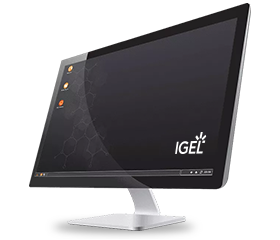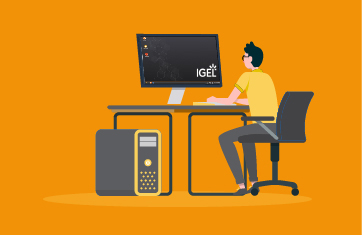What is IGEL COSMOS?
IGEL COSMOS is a powerful end user computing (EUC) platform for secure, managed access to any current and future digital workspaces. It includes IGEL's best-in-class endpoint device operating system (IGEL endpoint OS), as well as a powerful and easy-to-use management console, and multiple value-added cloud services.
What is IGEL OS?
IGEL OS is a secure, lightweight, and efficient endpoint OS that allows users to access any cloud-delivered digital workspace from any x86-64 device.
It makes endpoint devices more secure by separating apps and services from the base OS. You can install and update applications like Citrix, Chromium browser, etc. individually and independently from the IGEL OS base system.
IGEL OS is a hardened Linux operating system. The bespoke Linux OS requires far fewer resources to run than heavyweight full-featured OSs such as Windows 10 / 11 and IGEL OS can be installed on existing hardware, repurposing it as thin clients.
What is the IGEL App Portal?
The IGEL App Portal is a cloud service that delivers apps as part of the IGEL COSMOS platform. The IGEL COSMOS Cloud Services and apps are currently stored in Azure Region West-Europe, Amsterdam.
The IGEL App Portal is available directly at: https://app.igel.com/.
The IGEL App Portal delivers a full range of validated applications for use on IGEL OS-powered devices from IGEL’s vast IGEL Ready technology partner community of more than 130 partners. eG Enterprise monitoring for IGEL technologies has been fully validated via the IGEL Ready program and is available on the IGEL App Portal, here: eG Enterprise | IGEL.
What is IGEL UMS?
IGEL Universal Management Suite (UMS) can be used to remotely configure and control IGEL OS devices. The UMS supports not only various operating systems but also databases and directory services such as Microsoft Active Directory.
IGEL UMS is typically used for:
- Setting up devices automatically
- Configuring devices, software clients, tools, and local protocols
- Distributing updates
- Diagnostics and support
What is IGEL Cloud Gateway?
The IGEL Cloud Gateway (ICG) enables an IGEL Universal Management Suite (UMS) console administrator to fully manage and control end-user devices located “off network” – outside of the corporate LAN.
What Digital Workspace Technologies Are Used with IGEL Endpoints?
IGEL endpoints are often used with various digital workspace technologies to provide users secure and flexible access to their work environments. Some common digital workspace technologies used with IGEL endpoints include:
- Virtual Desktop Infrastructure (VDI): IGEL endpoints can connect to VDI environments such as Citrix Virtual Apps and Desktops, VMware Horizon, or Microsoft Remote Desktop Services (RDS) to deliver virtual desktops and applications to users.
- Desktop as a Service (DaaS): IGEL endpoints can also connect to DaaS platforms like Citrix Virtual Apps and Desktops Service, VMware Horizon Cloud, Microsoft AVD or Amazon WorkSpaces to access virtual desktops and applications hosted in the cloud.
- Unified Endpoint Management (UEM): IGEL endpoints can be managed and configured using UEM solutions such as VMware Workspace ONE, Microsoft Endpoint Manager, or Citrix Endpoint Management, enabling centralized control and administration of endpoints.
- Identity and Access Management (IAM): IAM solutions like Microsoft Azure Active Directory (now Entra ID), Okta, or Ping Identity can be integrated with IGEL endpoints to provide secure authentication and access control for users.
- Endpoint Security: IGEL endpoints can leverage endpoint security solutions such as antivirus software, encryption tools, and endpoint detection and response (EDR) solutions to protect against malware, data breaches, and other security threats.
- Collaboration Tools: IGEL endpoints can access collaboration platforms like Microsoft Teams, Slack, or Zoom to facilitate communication and collaboration among users.
- Remote Access: IGEL endpoints can utilize remote access solutions such as VPN clients, remote desktop gateways, or secure access service edge (SASE) platforms to enable secure remote connectivity to corporate networks and resources.
IGEL partners with many EUC vendors to provide optimizations pack / plugins for certain digital workspaces and applications. This is especially important with graphically intensive applications and unified communication technologies (voice and video calls) where certain graphical and audio data is best processed on the endpoint.
What are the Challenges to Monitoring Thin Clients such as those Enabled by IGEL Technologies?
Monitoring thin clients can present some unique challenges compared to traditional desktops.
- Limited Local Monitoring Capabilities: Thin clients typically have minimal local processing power and storage, which can restrict the ability to install and run monitoring agents or software directly on the client itself. This limitation may require alternative methods or specialized monitoring solutions that can gather information from the central server or network infrastructure. Since thin clients are often chosen for their nature as a secure locked-down solutions many organizations are reluctant to or prohibited by regulation from installing or using an agent on the endpoint. Any agented solution will need to implement specific security-oriented features. Many vendors offer APIs via which third-party solutions can access metrics, logs and other performance data.
- Centralized Monitoring: Since thin clients rely heavily on the central server or network for processing and data storage, monitoring often needs to focus on the server and/or cloud infrastructure and network performance. Monitoring tools should be able to gather data from server logs, performance metrics, and network traffic to gain insights into the thin client environment's overall health and performance.
- Network Dependency: Thin clients heavily depend on network connectivity to function properly. Any network issues or disruptions can impact the user experience and overall performance of the thin clients. Monitoring the network infrastructure, including switches, routers, and bandwidth usage, becomes critical to identify and address potential bottlenecks or connectivity problems. VDI and protocol monitoring is essential if thin clients are being used with those technologies. For an overview of Network Monitoring, please see: Network Monitoring - IT Glossary | eG Innovations.
- User Experience Monitoring: Monitoring the user experience is essential for ensuring thin clients deliver optimal performance. This includes monitoring application responsiveness, latency, screen updates, protocol behavior, and input/output responsiveness. User experience monitoring tools can capture user interactions, measure response times, and identify any performance degradation or usability issues.
- Security Monitoring: Thin clients play a role in data security, as sensitive information resides on the central server rather than locally on the client. Monitoring should encompass security aspects such as user authentication, access controls, and data transmission between the client and server. It is important to monitor for any unauthorized access attempts, anomalies in user behavior, or potential security breaches. Often it will be necessary to monitor third-party authentication and access technologies such as Azure AD (now Entra ID), Active Directory or Okta.
- Scalability and Volume: Monitoring thin clients in large-scale deployments can be challenging due to the sheer volume of clients and data generated. Monitoring systems should be able to handle large-scale deployments and efficiently collect, store, and analyze monitoring data from many thin clients. Solutions based around bespoke integrations with vendor APIs will usually offer better scalability than those that leverage SSH mechanisms.


